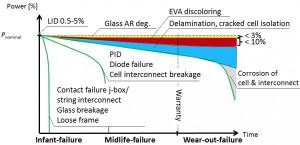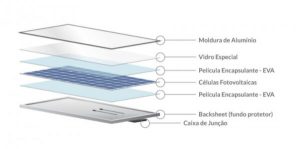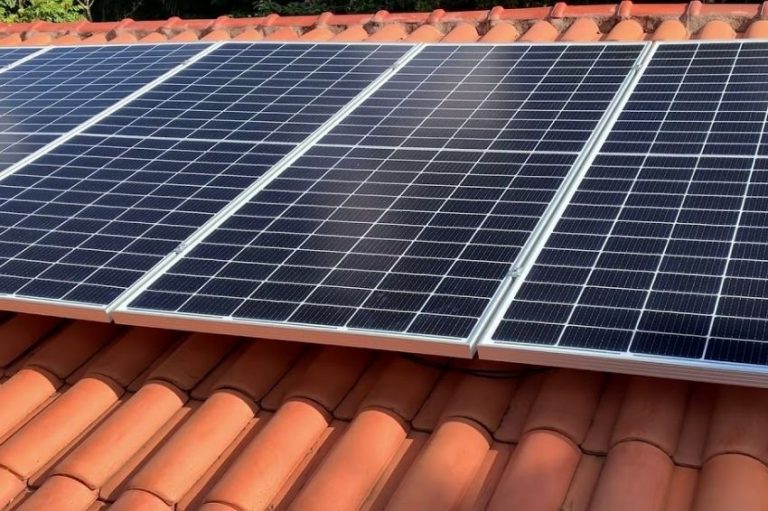Delamination is a problem caused by poor quality of materials or flaws in the manufacturing process of photovoltaic modules.
We call “delamination” the phenomenon of loss of adhesion of the different layers that make up the photovoltaic module.
This defect may appear at a very early stage, even shortly after module installation, and become serious throughout the life of the module.
The graph below shows the influence of various phenomena on the degradation of the power of photovoltaic modules. Delamination (blue region of the graph) is one of the biggest causes of power reduction throughout the useful life of the modules.

Why does delamination occur?
A photovoltaic module is made up of several layers of materials that are compacted in a heating and vacuum lamination process during manufacturing. Air and moisture must be completely eliminated in this process, to prevent them from remaining between the components of the finished module.
Different layers can lose their adhesion ability when manufacturing is inadequate or low-quality materials are used. Therefore, it is very important to guarantee the quality of products and use strict quality controls in the manufacturing process.

Delamination often originates from module manufacturing, when lamination does not occur perfectly.
One of the causes may be when the layers do not remain long enough in the so-called “laminator”, equipment responsible for gluing the glass, EVA (encapsulating film), backsheet cells (protective bottom) or rear glass.
Another cause is the use of low quality materials. Especially EVA and the backsheet are prone to losing their adhesion ability.
If we also take into account permanent exposure to climatic factors such as temperature, humidity and UVA irradiation, low quality modules may begin to delaminate soon after installation.
How is delamination detected?
Unlike other types of defects, which take time to be noticed, delamination can be detected with a visual inspection of the module.
Delamination can be noticed in the form of changes in the color of the module, milky stains on the front or the formation of bubbles on the back.

How does lamination affect the module?
When delaminations are far from the edge of the module, they negatively affect performance but are not necessarily a safety concern. However, these delaminations can extend and reach the edges of the module.
Delaminations at the edges can cause sealing failures that allow air and moisture to enter, which will cause corrosion of the cells and irreversible destruction of the module, affecting the integrity of the plant.
Ways to prevent delamination
To avoid this effect, it is recommended:
- Buy material from well-known and proven brands, with certified and transparent manufacturing processes;
- Care during transport. Modules are delicate equipment and must be palletized in a vertical position, among other precautions;
- Handle the module with care during installation of the material, in addition to following the manufacturer's assembly instructions;
- Check the plant regularly. In addition to permanent monitoring, it is advisable to carry out a visual inspection at least once a year and with special measuring equipment.
With all measures applied, delamination and many other defects can be effectively combatted. It's worth doing all the risk prevention work. The cost of repairing defects in solar plants increases the later they are discovered.
References
[1] Photovoltaic enemies – Delaminacion. Available in https://www.amara-e.com/enemigos-fotovoltaica-delaminacion/

















3 Responses
thermography
The annual inspection recommendation makes reference to the use of special measuring equipment. What are these equipment?
It is also important to list the names of reliable and certified manufacturers and/or suppliers.